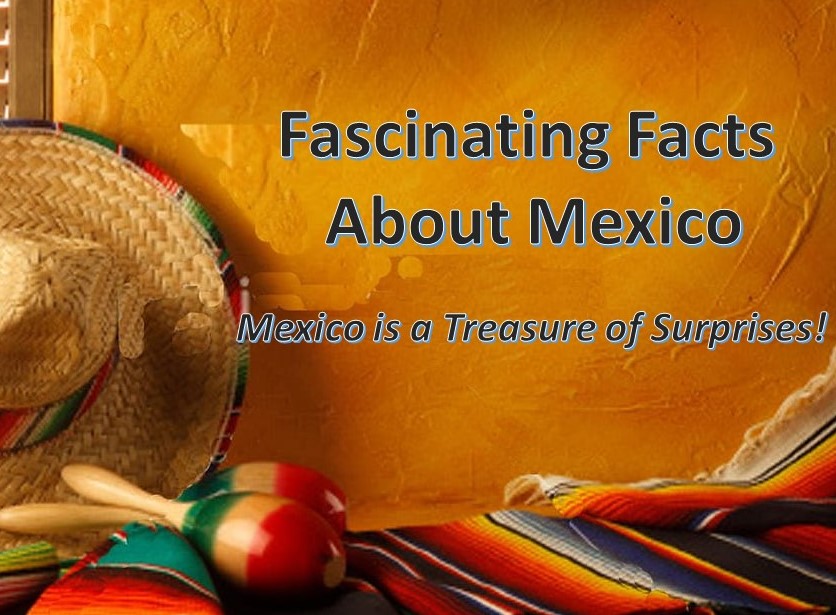Mexico is a Treasure of Surprises!
Editor’s Note: These facts have appeared on several social media pages. We added additional information, videos, and photos for you to enjoy. (Sources: #HistoriasDeMéxico; history.com; www.etymonline.com)
Mexico, the land of vibrant culture, rich history, and breathtaking landscapes, has always been a captivating destination for travelers worldwide. These fascinating and lesser-known facts about Mexico are amazing!
Its Name
“Mexico” is a name derived from the native Classical Nahuatl langage – “Mexihco”. Nahuatl is the original language of many of the native peoples of Mexico. The country’s official name is the United Mexican States.
Mexico Has the Most Spanish Speakers
In terms of their populations, as of 2021, Mexico is the country with the largest number of native Spanish speakers in the world. Colombia is the nation with the second-highest number of native Spanish speakers, Argentina is third, and Spain is fourth. There are 68 native languages and 364 recognized linguistic variants in the country in addition to Spanish.
Mexico Has Over 2.5 million African Descendants
In colonial times, Africans outnumbered the Spanish by 3 to 1. According to the 2020 Census, Afro-Mexicans and people of African descent comprise over 2.5 million, representing 2% of the country’s population. The population is concentrated in the states of Guerrero, Mexico, Veracruz, Oaxaca, and Mexico City.

Chocolate Origins: The Gift of the Gods
Many of us relish the delicious taste of chocolate, but few are aware that its origins can be traced back to Mexico. The ancient Mayans and Aztecs considered chocolate to be a divine gift from the gods. Chocolate was so valued in these ancient cultures that it was also used as currency. It wasn’t until later when the Spanish conquistadors brought chocolate back to Europe that sugar was added, leading to the sweet treat we know and love today.
Cenotes: Natural Sinkholes of Wonder
Mexico is home to an astonishing natural phenomenon called “cenotes.” These are sinkholes formed by the collapse of limestone bedrock, revealing stunning underground pools of crystal-clear water. The Yucatan Peninsula is particularly famous for its cenotes, which offer a unique experience for adventurous travelers who can swim and explore these hidden gems amidst lush jungle surroundings.
Mexican Jumping Beans: A Living Curiosity
Mexican jumping beans are intriguing novelties that have captured the imagination of people around the world. These “beans” are, in fact, seed pods inhabited by the larvae of a small moth known as the jumping bean moth. The movements inside the seed pods are caused by the larva’s attempts to position itself for optimal warmth. Observing their wriggling is a peculiar and fascinating experience.
A Land of Volcanoes
México is home to over 3,000 volcanoes, out of which 14 are considered active. The iconic Popocatepetl and Colima are among the most well-known active volcanoes in the country.
The iconic Popocatepetl volcano.
Mariachi: UNESCO Intangible Cultural Heritage
Mariachi, the vibrant and soulful music genre that embodies the spirit of México, is recognized as a UNESCO Intangible Cultural Heritage. Originating in the state of Jalisco, mariachi music is characterized by its distinctive instrumentation, including trumpets, violins, and the guitarrón, a large bass guitar. The musicians, dressed in traditional “charro” outfits, passionately perform songs that often tell stories of love, pride, and Mexican heritage.
The Colorful Magic of “Papel Picado”
“Papel Picado” translates to “perforated paper,” and it is a form of decorative folk art that holds immense cultural significance. Artisans skillfully cut intricate patterns into colorful tissue paper, creating delicate banners used to decorate streets, homes, and altars during various festivities, especially during the Day of the Dead (Día de los Muertos) celebrations. The art form’s origins date back to pre-Hispanic times, making it a cherished part of México’s cultural heritage.
The Largest Pyramid in the World
México, not Egypt, is home to the largest pyramid in the world – the Great Pyramid of Cholula, measuring 450 meters by 450 meters, rising 55 meters above the plain. Its construction began around 300 BCE.
The Largest University in the World
UNAM has more than 360,000 enrolled students, making it the largest in the world. It was founded in 1551, which also makes it the oldest university in North America.
Mexico is a Treasure of Surprises!
From its intriguing historical contributions to its stunning natural marvels, Mexico is a treasure of surprises waiting to be explored. Whether you’re savoring the origin of chocolate, marveling at the beauty of cenotes, or tapping your feet to the tunes of mariachi, Mexico will undoubtedly leave an indelible mark on your heart and soul.
References:
history.com; www.etymonline.com
Related Articles:

